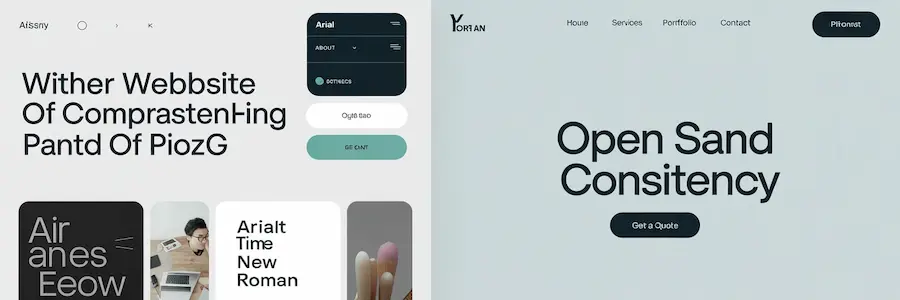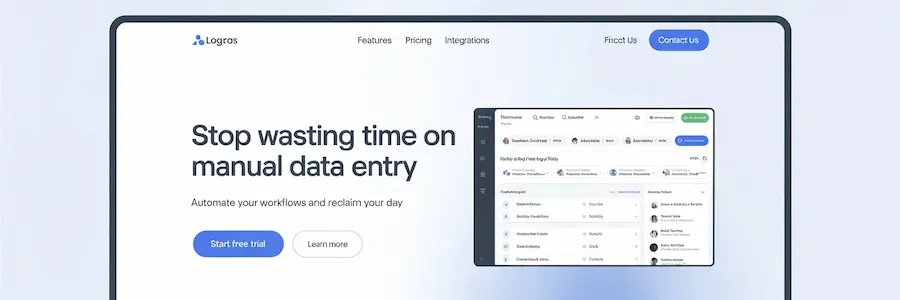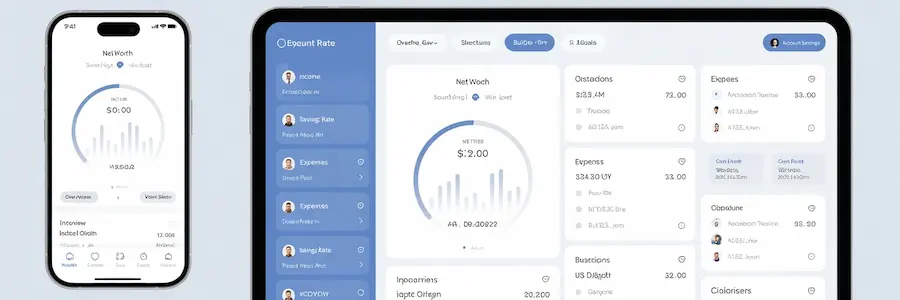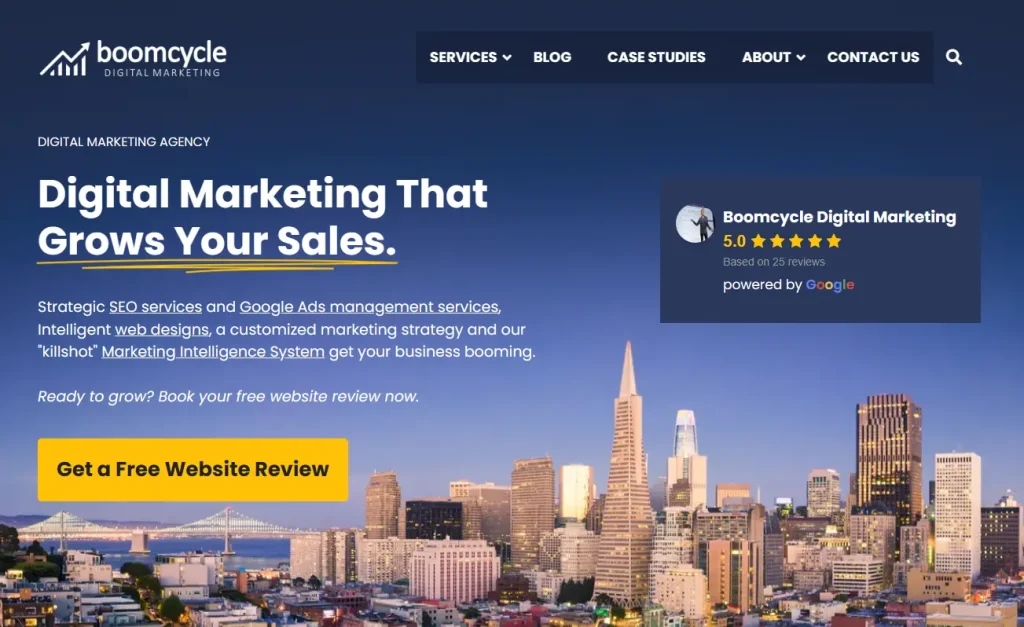Your website is often the first impression potential customers get. And like any first impression, you only get one shot to get it right.
Most businesses treat their website like an afterthought, throwing up some basic pages and hoping for the best. But visitors form an opinion about your site in just 50 milliseconds.
That’s faster than a blink.
The difference between websites that convert and those that don’t comes down to understanding a few core principles. Brand consistency that builds immediate trust. Calls-to-action that actually guide people toward taking the next step. Stories that connect with your audience’s real problems.
This guide walks you through the essential elements that separate amateur websites from professional ones. You’ll learn how to align your design with your company’s mission, create seamless user experiences across devices, and build pages that keep visitors engaged instead of bouncing away.
Because when your website works properly, it becomes your most effective salesperson—one that never takes a day off.
Do You Need a New Web Design?
It’s sometimes tempting to think that a new web design is the answer to all your problems. After all, if you have an outdated website or one that isn’t visually appealing, it could be driving away potential customers.
But oftentimes, the issue isn’t with the design itself—it’s with your SEO and other digital marketing strategies. Simply put: no one is finding your website in the first place (have you checked your Google Analytics to find out if anyone is visiting?)
Presuming you are getting visitors to your website, the next thing to look at is whether or not your website is converting visitors to buyers.
But before we get too deep “in the weeds”, it’s best to work from the inside out, starting with your business. We need to get answers to the most important questions:
- What are your most valuable products or services you wish to promote?
- Who are your ideal prospects?
- What is the message you need to convey to them?
- What action do you want them to take when visiting your website?
Once you have answers to these vital questions, you can start to think about a website design that would support your mission.
Many factors contribute to a powerful web design.

Brand Identity: The Foundation That Makes Everything Else Work
Your brand identity creates the visual and emotional framework for every decision on your website. This means your color palette, typography, imagery style, and tone of voice should feel like they came from the same creative mind—because they should reinforce the same core message about who you are.
Take your logo placement. Instead of slapping it randomly in corners, consider how it works with your navigation and key messaging. Your fonts should reflect your personality—modern sans-serif for tech companies, elegant serifs for luxury brands, playful scripts for creative services. These aren’t arbitrary choices; they’re psychological triggers that help visitors categorize and trust you within seconds.
Stories That Actually Convert
Most businesses confuse storytelling with rambling about their company history. Effective web storytelling focuses on your customer’s transformation—the problem they face, the struggle they experience, and how your solution changes their situation.
For example, a project management software company might lead with “Sarah used to spend three hours every Monday morning trying to figure out where her team’s projects stood” rather than “Founded in 2019, we’re passionate about productivity solutions.”
The story structure that works: current frustrating state → desired future state → your role as the guide who helps them get there.
Hero Sections That Actually Work
Your hero section has one job: help visitors immediately understand whether they’re in the right place. This requires three elements working together—a clear headline that addresses their specific problem, a subheadline that explains your unique approach, and a visual that supports (not distracts from) this message.

Skip the generic stock photos of people pointing at laptops. Use visuals that show your product in action, your results in context, or your customers experiencing the transformation you provide.
CTAs That Feel Natural
The best call-to-action buttons feel like logical next steps.
Instead of “Buy Now,” try “See How It Works” or “Get Your Custom Quote.” The language should match where someone is in their decision-making process.
Place these strategically after you’ve built value, not before. Someone needs to understand what you’re offering and why it matters before they’ll consider taking action.
Navigation That Actually Helps
Usability comes down to one principle: can someone find what they’re looking for without thinking too hard about it? This means organizing your navigation around customer needs, not internal company structure.
Instead of “About, Services, Products, Contact,” consider “How It Works, Pricing, Customer Results, Get Started.”
Test your navigation by asking a friend or your mom, who’s likely unfamiliar with your business, to find specific information—their confusion points reveal where you need to simplify.
Mobile-First Design (Because That’s Where Your Traffic Is)
Responsive design isn’t about making your desktop site work on phones—it’s about designing for mobile first, then scaling up. This shifts your entire approach toward cleaner layouts, faster loading times, and more focused content.
Check your mobile experience monthly. Load times, button sizes, form completion—these details determine whether mobile visitors convert or bounce.

Content Management That Gives You Control
A good CMS like WordPress, Wix, Webflow, or Squarespace lets you update content, add pages, and modify designs without calling a developer every time. This matters because your website should evolve as your business grows—new services, updated pricing, fresh case studies.
Choose a platform that matches your technical comfort level while giving you room to grow. The best CMS is the one you’ll actually use to keep your content current.
Brand Identity and Brand Consistency
Having a strong brand identity is essential for any business, especially in the B2B market. A consistent brand identity across all platforms helps to build trust with customers and create a recognizable presence in the market.
It’s essential that your website design reflects your company’s values and mission statement. Your logo should be prominently displayed on every page of your website, along with consistent colors, fonts, and imagery throughout. This will help visitors quickly identify who you are as soon as they land on your site.
Your social media accounts should also have the same look and feel as your website so that customers can easily recognize you no matter where they find you online. Make sure to use similar logos, color schemes, language styles, etc., so that people know it’s still you even if they’re not looking at an official webpage or blog post from your company.
Typography plays a major role in how your brand is perceived.
The fonts you choose and how you use them can communicate authority, friendliness, innovation, or tradition before visitors even read your content. Well-implemented typography improves readability, reinforces brand identity, and creates visual hierarchy that guides users through your content.
When selecting fonts for your website, consider both aesthetics and functionality. Web-safe fonts like Arial, Georgia, and Verdana are available on virtually all devices, ensuring consistent display. Web font services like Google Fonts (free) and Adobe Fonts offer wider creative options while maintaining good performance when properly implemented.
For optimal loading speed, limit your selection to 2-3 font families maximum and various weights within those families.
Proper font hierarchy helps users scan and understand your content quickly. Use size, weight, and color variations to distinguish between headings, subheadings, body text, and calls to action. Maintain sufficient contrast between text and background colors, with a minimum ratio of 4.5:1 for normal text and 3:1 for large text to meet accessibility standards.
Line height (the space between lines of text) and letter spacing also impact readability.
Generally, body text looks best with line height set to 1.5-2 times the font size. Appropriate spacing prevents text from feeling cramped and makes content more approachable, especially on mobile devices where screen space is limited.
Brand consistency also extends beyond visuals into content creation too – make sure each piece of content has a clear purpose and message behind it that ties back to what makes your business unique or special in some way. Storytelling is key here; craft compelling stories about how customers have benefited from using/buying from you before which will help them better understand why they should choose you over competitors when making their decision-making process easier for them overall.
Finally, don’t forget about call-to-actions (CTAs). CTAs are essential for guiding potential customers through the sales funnel by providing actionable steps such as signing up for newsletters or downloading resources related to their interests – these small but powerful touches can go a long way towards increasing conversions.
Having a consistent brand identity is key to making sure your business stands out in the market and resonates with customers. By building an effective storytelling framework, you can create a strong foundation for successful marketing campaigns.
Storytelling Framework
Storytelling is an essential part of any successful B2B marketing strategy. It helps to create a connection between the business and its customers while also providing valuable information about the company’s products or services. A classic storytelling framework consists of three main elements: protagonist, plot, and resolution.
Protagonist
The protagonist in your story should be someone that readers can relate to – whether it’s a customer, employee, or even yourself as the business owner. This person should have a problem that needs solving by using your product or service. For example, if you are selling accounting software for small businesses, your protagonist could be a small business owner struggling with their finances due to manual bookkeeping processes.
Plot
The plot of your story should provide insight into how the protagonist solves their problem by using your product or service. You can do this through case studies where you showcase how other customers have used your product successfully, testimonials from existing customers, or stories from employees who use the product on a daily basis.
Resolution
Finally, you need to provide readers with some kind of resolution at the end of your story so they know what happens after they purchase and use your product/service. This could include statistics such as increased sales numbers, customer feedback about improved efficiency, or simply an overall feeling of satisfaction when using the product/service for themselves.
A good Storytelling Framework provides a powerful foundation for creating engaging content that resonates with your audience.
Now let’s explore how to craft the perfect hero section for your business website design.
The Perfect Hero Section
A hero section is the first thing visitors see when they land on your website. It’s a powerful way to make an impact and set the tone for the rest of their journey. When done right, it can be transformational in terms of how customers perceive your business and products or services.
I have kind of a “formula” that I believe describes the perfect hero section. Here are the five essential elements:
- A transformational statement that speaks directly to your audience’s needs and desires.
- A description of how you help them achieve the transformation they want in simple language that resonates with them.
- Let them visualize themselves using your product or service by providing visuals such as images, videos, or illustrations that showcase its features and benefits.
- Social proof that includes customer testimonials or reviews from trusted sources like Google Reviews or Yelp. These will show potential customers that others have had success with what you offer so they feel more confident about making a purchase decision.
- Finally, make taking action easy by including clear calls-to-action (CTAs) such as “Connect With Us Today” buttons which direct users to other pages on your site where they can find out more information about what you offer.

Note that people are sometimes a little weird about CTAs. Too much commitment scares people off. Too little, and you don’t compel them to take any action. For example, “Learn more” is a CTA that’s especially flaccid.
By following these tips for creating an effective hero section, you can ensure visitors are engaged from the moment they arrive at your website and take one step closer towards becoming loyal customers who keep coming back time after time.
A great hero section should capture the attention of your audience and encourage them to take action. Now, let’s discuss how to create effective call-to-actions that will help you convert visitors into customers.
Call-to-Actions
Call-to-actions (CTAs) are an essential element of any website. They provide a way for visitors to take action, such as signing up for newsletters or making purchases. CTAs can be used in various ways, from buttons and links to forms and banners. No matter how they’re implemented, effective CTAs should be visible, relevant and engaging.
When designing your call-to-action elements, it’s important to keep the user experience in mind. Make sure that your CTA is easy to find on the page by using contrasting colors or adding visual cues like arrows pointing towards them. Additionally, ensure that all necessary information is included in the CTA so users know exactly what will happen when they click it – this could include anything from confirming their subscription details or providing payment information.
Your CTA should also be relevant to the content on the page – if you’re talking about a product then make sure your CTA encourages people to purchase it. You can use language like “Buy Now” or “Add To Cart” which clearly communicates what action needs to be taken next. Finally, try using persuasive copywriting techniques such as creating urgency with words like “Hurry.” or emphasizing benefits with phrases like “Get Yours Today.”
The effectiveness of your call-to-actions depends heavily on their placement within your website design too; consider placing them at strategic points throughout pages where visitors are likely ready to take action such as after reading key pieces of content or near related products/services etc. By taking these steps, you can ensure that more visitors convert into customers through effective calls-to-action than ever before.
Call-to-Actions are an essential part of any website design and can help drive conversions. Now, let’s look at how usability plays a role in effective web design.
Key Takeaway: To create effective CTAs, make sure they are visible, relevant and engaging. Use contrasting colors or visual cues to draw attention, include all necessary information and use persuasive copywriting techniques. Place them strategically on the page for maximum conversions.
Usability
Usability is a key element of any website design. It’s the measure of how easy it is for users to find what they need on your site and interact with it in an intuitive way. Poor usability can lead to frustrated customers, lost sales, and even negative brand perception.
Good usability should be at the forefront of any web design project. Clear navigation menus that are easy to use will help visitors quickly find what they’re looking for without getting lost or confused. Calls-to-action should be clearly visible and designed in such a way that encourages users to take action. Intuitive design elements like dropdown menus, collapsible sections, and hover effects make navigating your website easier than ever before.
Designing with responsiveness in mind is also important when considering usability as more people access websites from mobile devices every day. Responsive designs adjust automatically based on device size so that all content remains accessible regardless of whether someone is using their phone or laptop computer to view your site. This ensures that everyone has the same great experience no matter where they’re accessing your website from.
Finally, selecting the right CMS (Content Management System) can have a huge impact on usability as well since some systems are much easier to work with than others when it comes time for updates or changes down the road. It is important to research different options carefully before making a decision so you know you will have something reliable and user friendly going forward.
Usability is an important factor in creating a successful website, and it’s essential to ensure that the user experience is easy and intuitive. Responsiveness should be considered when designing a website as well, to ensure optimal performance on all devices.
“Don’t let your website be a usability nightmare. Make sure it’s intuitive, responsive and easy to use for the greatest liklihood of converting a visitor into a customer.”
David Victor, Founder, Boomcycle Digital Marketing
Web Accessibility Standards
Web accessibility is not just a nice-to-have feature, it’s becoming a business necessity. Accessible websites ensure that people with disabilities can perceive, understand, move around, and interact with your site effectively. Beyond being the right thing to do, it can protect your business from potential legal issues.
The Web Content Accessibility Guidelines (WCAG) provide the standards most commonly referenced when discussing web accessibility. The current version, WCAG 2.1, released in 2018, builds upon previous standards with additional criteria focused on mobile accessibility, people with low vision, and people with cognitive and learning disabilities.
These guidelines are organized around four key principles, often referred to by the acronym POUR:
- Perceivable: Information must be presentable to users in ways they can perceive. This means providing text alternatives for non-text content and creating content that can be presented in different ways.
- Operable: User interface components and navigation must be operable. This includes making all functionality available from a keyboard and giving users enough time to read and use content.
- Understandable: Information and operation of the user interface must be understandable. This means making text readable and predictable, and helping users avoid and correct mistakes.
- Dependable: Content must be solid enough to be interpreted reliably by a wide variety of user agents, including assistive technologies.
I’ve seen many businesses scramble to update their websites after receiving legal notices about accessibility issues. Several court cases have established websites as places of public accommodation under the Americans with Disabilities Act (ADA), making accessibility compliance a legal requirement for many businesses.
Implementing accessibility doesn’t have to be overwhelming. Start with these practical steps:
- Use proper heading structure (H1, H2, H3, etc.) to create a logical content hierarchy
- Add alt text to all images that convey information
- Ensure sufficient color contrast between text and background
- Make sure all functionality is keyboard accessible
- Provide labels for all form fields
You can use tools like WAVE (Web Accessibility Evaluation Tool) or Google Lighthouse to check your site’s accessibility and identify issues that need fixing. Remember that accessibility benefits everyone, not just people with disabilities. Clear navigation, readable text, and well-structured content improve the experience for all users.
Responsiveness
Responsiveness is a key factor in website design. It refers to the ability of a website to adapt its layout and content based on the size of the device it’s being viewed on. Responsive websites are designed with fluid grids, flexible images, and media queries that enable them to adjust their layout according to the screen size they’re being viewed on.
Having a responsive website is essential for businesses today because more than half of all web traffic comes from mobile devices such as smartphones and tablets. If your site isn’t optimized for these devices, you’re missing out on potential customers who may be turned off by having an experience that’s not tailored for their device or browser type.
Over 60% of global web traffic now comes from mobile devices. As of May 2025, mobile devices account for approximately 63% of all website traffic worldwide. This shift occurred steadily over the past decade, with mobile web traffic surpassing desktop for the first time in 2017 and remaining the dominant channel ever since.
As a result, mobile-first design has become the standard approach for modern web development. This strategy involves designing for the smallest screens—typically smartphones—first, and then progressively enhancing the design for larger screens like tablets and desktops. The rationale is straightforward: by focusing on mobile constraints and user needs first, designers ensure that essential content and functionality are accessible to the largest and fastest-growing segment of users.
The mobile-first approach isn’t just about screen size, it’s about prioritization.
Force yourself to design for the constraints of mobile devices, and you’ll naturally focus on what’s most important for your users. This clarity often leads to better designs across all devices (eh, except desktop, where you may really start to wonder if anyone looked at this “view” if the design is truly “mobile-first”!)
A responsive website also helps improve user experience by providing users with an intuitive navigation system that works across multiple platforms. This makes it easier for visitors to find what they need quickly without having to scroll through pages or resize windows manually. Furthermore, when visitors have a better user experience, they are more likely to convert into paying customers – something every business wants.
Additionally, search engines like Google favor sites that are mobile-friendly since most people use mobile devices when searching online nowadays; this means if your site isn’t optimized for smaller screens then you could be losing out on valuable organic traffic from search engine results pages (SERPs). As such, making sure your site is responsive can help boost SEO rankings which can lead to increased visibility and higher conversion rates in the long run.
Finally, responsiveness ensures consistency across different browsers so regardless of whether someone visits your site using Chrome or Safari – both versions will look identical no matter what device they’re viewing it from. This eliminates any confusion caused by discrepancies between desktop and mobile versions which can often frustrate users, leading them away from completing conversions or signing up for services/products offered by your business.
When designing a website, responsiveness is key to ensuring that users have an optimal experience regardless of the device they are using. Now let’s take a look at CMS considerations when creating a business website.
Key Takeaway: A responsive website is essential for businesses as it helps improve user experience, boosts SEO rankings and ensures consistency across different browsers. Key elements include: fluid grids, flexible images, media queries and intuitive navigation systems.
Performance Optimization
Website speed is now a non-negotiable factor in digital success. More than half of mobile users will leave if a site takes more than three seconds to appear. Even a single second of lag can send your conversion rates tumbling.
Fast-loading pages aren’t just about keeping visitors happy—they’re also favored by Google’s ranking algorithms, which now factor in site speed as a key ranking signal.
To make things even more interesting, Google rolled out Core Web Vitals as ranking signals in 2021. These metrics put a spotlight on real-world user experience:
- Largest Contentful Paint (LCP): This tracks how quickly the main content loads. Aim for under 2.5 seconds.
- First Input Delay (FID): This measures how fast your site responds to a user’s first interaction. Keep it below 100 milliseconds.
- Cumulative Layout Shift (CLS): This gauges how stable your layout is as the page loads. A good score is less than 0.1.
If your site’s performance is lagging, don’t panic. There are plenty of ways to speed things up and keep both users and search engines on your side.
Image optimization/compression is often the quickest win.
Large, uncompressed images are usually the biggest culprits in slow-loading pages. Use modern formats like WebP which provide better compression than older formats like JPEG and PNG. Implement lazy loading so images only load when they’re about to come into view.
Minimize HTTP requests by combining files where possible.
Each piece of JavaScript, CSS, or image requires a separate HTTP request, so fewer files mean faster loading times. Minifying your code by removing unnecessary characters and white space can also reduce file sizes significantly.
Browser caching lets you temporarily store commonly used files on a visitor’s device. This means when they browse to a new page or return to your site, their browser doesn’t have to reload the entire page. Setting appropriate cache times can dramatically improve speed for returning visitors.
Content Delivery Networks (CDNs) store copies of your site on multiple servers around the world, allowing users to download your site’s files from the server closest to them. This reduces latency and speeds up page load times, especially for visitors from different geographic locations.
Use tools like Google PageSpeed Insights, GTmetrix, or WebPageTest to measure your site’s performance and identify specific issues that need addressing.

Unlock your business potential with our expert digital marketing services.
CMS Considerations
When it comes to web design, choosing the right content management system (CMS) is essential. A CMS allows you to easily update and manage your website over time. Popular options include WordPress, Wix, Squarespace, Webflow, Drupal, Joomla and more. Each of these platforms has its own pros and cons for businesses in terms of cost, scalability, security and other factors.
WordPress is one of the most popular CMSs due to its user-friendly interface and wide range of features that make it easy for users with any level of technical experience to create a professional website quickly. It also offers plenty of plugins that allow you to customize your site even further.
However, WordPress can be slow when dealing with large amounts of data or complex websites. For example, when I click “Save” on this article, it takes about 10+ seconds to finish saving. That’s super-annoying.
Your selection of a “theme” has a lot to do with usability and website speed. This website currently uses Elementor, though I want to switch it to Generate Press, which is much faster and “lighter” (less for a web browser to load).
New competitors such as Webflow attempt to make the design task simpler. Almost invariably, they simply introduce new problems.
The horrible Drupal is another option that’s sometimes used by larger organizations due to its capabilities such as multi-site support and granular access control settings which allow administrators to limit who can view or edit certain parts of their site. While this makes Drupal ideal for enterprise applications, it does require some technical knowledge in order to use effectively so may not be suitable for smaller businesses or those without an IT team on hand.
Joomla is another choice if you need something between WordPress’ simplicity and Drupal’s complexity, offering plenty of features while still being relatively easy-to-use compared with other CMSs like Magento or Shopify Plus which are designed specifically for ecommerce sites rather than general websites.
Ultimately, there isn’t one perfect solution when it comes to selecting a CMS. Each platform has different strengths depending on what type of website you’re building, so it is important that business owners take the time to research their options before making a decision about which one will best suit their needs now and into the future as their business grows.
Key Takeaway: When selecting a CMS, it is important to consider the features, scalability and cost of each platform. Popular options include WordPress, Drupal and Joomla – each with their own pros and cons. Research your options before making a decision that will best suit your needs now and into the future.
FAQs in Relation to Business Website Design 101
What are the 7 principles of web design?
1. User Interface: Design an intuitive and user-friendly interface that is easy to navigate and understand.
2. Content Strategy: Develop a content strategy that focuses on providing useful, relevant, and engaging information for users.
3. Responsive Design: Ensure your website works across all devices by using responsive design techniques such as fluid grids, flexible images, media queries etc.
4. Performance Optimization: Improve the loading speed of your website by optimizing code, compressing images and leveraging caching technologies like CDNs (Content Delivery Networks).
5. Accessibility & Usability: Make sure your website is accessible to people with disabilities by following web accessibility guidelines such as WCAG 2 AA standards or Section 508 requirements for government websites in the US .
6. Search Engine Optimization (SEO): Increase visibility of your website in search engine results pages (SERPs) through optimization techniques such as keyword research, link building campaigns etc., so more potential customers can find you online easily .
7. Security & Privacy Protection: Protect sensitive data from unauthorized access or malicious attacks by implementing security measures like SSL certificates and other encryption protocols on your server side infrastructure .
What are the basics of designing a website?
Designing a website requires careful planning and consideration of several key elements. First, you must decide on the purpose of your website and what content will be included. Next, choose an appropriate domain name that reflects your business’s brand identity. Afterward, select a hosting provider to store your site’s files and make it accessible online. Finally, create or customize a template with attractive visuals and intuitive navigation for visitors to explore easily. With these steps in place, you can launch a successful website that meets the needs of your target audience.
How do I make a business website for beginners?
Creating a business website is easier than ever before. To get started, choose a domain name and hosting provider that meets your needs. Then use an easy-to-use website builder to design the look and feel of your site. Finally, add content such as images, text, videos or other media to create engaging pages for visitors. Once you’ve completed these steps, launch your website and start promoting it online with SEO techniques like keyword research and link building to drive more traffic to your site.
The Wrapup!
A professional website design is essential for any business. It requires careful consideration of brand identity and consistency, storytelling framework, the perfect hero section, call-to-actions, usability and responsiveness.
Businesses should also consider CMS when designing their websites to ensure that they are able to effectively manage their content in a timely manner.
By taking these steps into account when designing your website, you can create a user experience that will help build trust with potential customers and increase conversions.
Want more of your best clients to know you exist? Contact Boomcycle Digital Marketing today and we’ll be happy to help!








